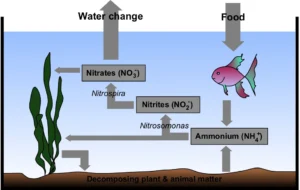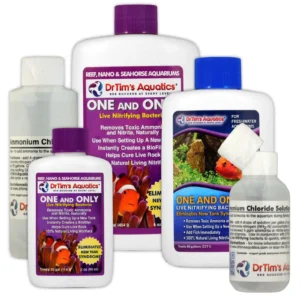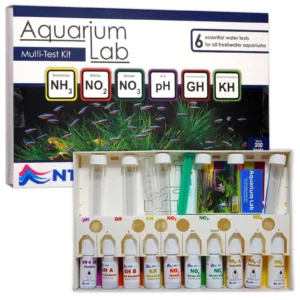In any fish tank we’re trying to create as near as possible a natural environment for our fish.
It doesn’t matter whether it’s a fresh or saltwater tank or how large or small the tank is.
And the first thing we need to understand is how the nitrogen cycle works and how it affects a fish tank.
Table of Contents
The Nitrogen Cycle
In any body of water, be it the sea, a river or stream, small pond or large lake, fish and other animals produce waste.
(As does decaying vegetable matter or dead and decaying fish and animals.)
This waste produces Ammonia which, if in sufficient quantity, will poison the water and kill the inhabitants.

Fortunately mother nature has had millions of years to solve this problem and it does so using bacteria in a biological process called the Nitrogen Cycle.
When ammonia is available beneficial bacteria in the water called nitrosomonas consume it, which is great but in doing so they produce Nitrite as a waste product which is also toxic to fish and other animals. Oh no! But don’t worry mother nature hasn’t finished yet…
A second type of bacteria present in the water called nitrospira now consume the nitrite and convert that into Nitrate which is both far less toxic and is in fact used by many aquatic plants, corals, etc. as food to help them grow.
Now in the wild this process (or cycle) has been going on for millennia and takes place on a continuous basis, Waste > Ammonia > Nitrite > Nitrate and is therefore in balance and just happens but in a fish tank we have to think more carefully about it…
Cycling a New Fish Tank
Too many people over the years have bought a brand new fish tank, set-it up and then added fish straight away only for the fish to die a few days, or maybe even a few weeks, later.
This is obviously bad for the fish but it has also put many people off the hobby for good. If only they had known how to cycle a new fish tank in the first place.
What’s needed is to recreate the natural Nitrogen Cycle in the fish tank.
So, how do we do this? There are a number of different methods…
Cycling a Fish Tank with Fish
I’ll mention this method first, as you may hear about it but only to council against using it.
The idea is you add a couple of cheap fish which will produce waste and therefore ammonia. The good bacteria will eventually arrive to convert that first into nitrites and then nitrates.
But this process can take 6 – 12 weeks during which time the fish will be exposed to both toxic ammonia and nitrite for several weeks.
If they even survive it won’t do their long term health any good so please avoid using this method.
Cycling a Fish Tank Without Fish
Also known as fishless cycling and it’s done by introducing an alternative ammonia source other than waste produced by fish.
This can be done by directly adding bottled ammonia or by simply adding fish food and letting it decay in the tank.
This waste will then kick start the nitrogen cycle as the beneficial bacteria arrive to convert the ammonia to nitrites and then nitrates. Again this process will take 6 -12 weeks and when the cycle is completed it is safe to add fish.
A couple of more general points are worth noting at this point:-
Firstly, remember we are trying to encourage beneficial bacteria to develop in our tanks. Most tap water contains chlorine (and other elements) designed to kill bacteria in the water and make it safe for us to drink. But these antibacterial agents will also kill our good bacteria needed for the nitrogen cycle.
So, when using tap water it’s important to add a dechlorinator to the water whenever you add water to your tank. This removes the chlorine and makes the water safe for our good bacteria. Dechlorinators can be bought at any good aquarium store or online.
Secondly, our nitrogen cycle has an end result of nitrates which can, if they get high enough, also be poisonous to our fish.
To lower them we can simply do a water change where 10 – 50% of the old nitrate rich water is removed from the tank and replaced by fresh ‘clean’ water, thereby reducing the nitrate level.
Note: our good bacteria is not removed from the tank by a water change as it primarily lives in our filters, substrate, etc.
Cycling a Fish Tank using Bacteria Cultures

Ok so how do these good bacteria arrive in our tanks in the first place?
The short answer is these bacteria are everywhere in nature and have been for millennia and they will arrive and develop in any water body, large or small, fresh or saltwater.
You just have to wait for them to turn up and do their magic…
Or do you?..
As you might expect, in this scientific age, certain bacterial cultures have been developed that can speed up the whole process for fish tank keepers.
There are various different types of bacterial cultures you can get and I’ll be looking at them in more detail in a later article.
Some basically replicate the natural nitrogen cycle and you still need to wait until your tank is free from ammonia and nitrite, whilst others allow you to add fish straight away.
Bacterial cultures can be bought at any good aquarium store or online. Check out our Best Fish Tank Bacteria Supplements article advising you on the ones to look out for.
Remember though, and particularly with a new fish tank, don’t add too many fish at once or you could overload the tank’s biological ability to process the waste.
Add fish over time allowing your biological culture time to increase and cope.
Testing your Fish Tank

One final point to cover is how do you know when ammonia , nitrite and nitrate are present in your tank and how can you keep track of the nitrogen cycle in a new tank?
The answer is testing.
As a new tank cycles you would first test that ammonia is present and then test for nitrites. Ammonia should decrease as nitrite increases and then finally you test for nitrates.
Once nitrates appear ammonia and nitrite should go to zero while nitrates climb until a water change reduces them.
There are various different test kits that you can get.
For a freshwater fish tank, our article, Best Test Kits for a Freshwater Fish Tank, will point you in the right direction.
For a saltwater tank, follow our guidance in this article, Best Test Kits for a Saltwater Fish Tank.
How to Cycle a Fish Tank FAQs
Is it necessary to cycle a fish tank? – Yes, fish produce waste and with decaying uneaten food, etc this leads to Ammonia building up which is poisonous for your fish.
Cycling a tank means beneficial bacteria are allowed to cultivate that will consume the ammonia and turn it, first into Nitrites and then, far less harmful, Nitrates. Excess nitrate can then be removed by water changes.
How long does it take for a fish tank to cycle? – If left to nature’s own devices, cycling a tank can take from 4 – 8 weeks as the beneficial bacteria takes time to grow.
What is the fastest way to cycle a new fish tank? – The fastest way to cycle a fish tank is to introduce beneficial bacteria from the outset.
Some bacteria cultures reproduce the natural nitrogen cycle and still take time, whilst others allow you to add fish immediately.
Read our article, Best Fish Tank Bacteria Supplements for more guidance.
How do I know if my tank is cycled? – You’ll know your tank is cycled when Ammonia and Nitrite levels are zero and you have Nitrates present in your tank.
The only way to establish that is by testing. For more information please refer to our articles, Best Test Kits for a Freshwater Fish Tank, and Best Test Kits for a Saltwater Fish Tank.
